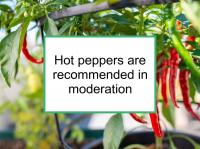Hot peppers include peppers of many varieties in the genus Capsicum that are characterized by intense heat resulting from their capsaicinoid contents. Examples include cayenne chili peppers, hot chilli peppers, jalapeño peppers, and Sichuan peppers. Also included in this category are hot sauce, chili powder, sriracha sauce, and red pepper flakes.
Not included are black pepper, paprika or bell peppers (or other mild or sweet peppers). By hot sauce, we mean supermarket sauces such as Tabasco Sauce and various Louisiana hot sauces, as well as specialty sauces advertised as fiery or hot in which the heat is derived from capsaicin-containing peppers. By chili powder, we mean the common supermarket spice mixture made primarily from the dried, ground fruit of red chili peppers (Capsicum annum), as well as specialty chili powders advertised as hot.
Hot peppers have been shown to have anti-inflammatory, antioxidant, antiarthritic, analgesic, and antithrombotic properties and may improve cholesterol levels and glucose metabolism and assist in weight loss. Most peppers are good dietary sources of capsaicin, beta-carotene, lycopene and some capsanthin (red varieties) and vitamin C, as well as flavonoids such as quercetin and luteolin.
Studies concerning hot peppers, capsaicin and cancer have produced mixed results. On the one hand, capsaicin has been shown to induce apoptosis in several different types of cancer cells and mechanisms have been proposed to explain its apparent anti-cancer activity. On the other hand, capsaicin also appears to act as a carcinogen in some parts of the body.
As noted above, capsaicin has been shown to induce apoptosis or have chemoprotective actions in the laboratory in a variety of human cancer cells, including lung, pancreatic, bladder, colon, urothelial, and prostate cancer cells. Population studies have found hot pepper consumption to be associated with lower risks of lung and liver cancers. The population-based evidence with respect to colon cancer is inconsistent.
Frequent consumption of hot peppers has been found to be associated with esophageal, gall bladder and gastric (stomach and intestinal) cancers in multiple population studies. In Chileans (who have among the highest rates of gall bladder cancer in the world), those with the highest intake of red chilli peppers and a history of gallstone disease have the highest risk of developing gall bladder cancer. One Mexican study found that intake of capsaicin was associated with increased risk of gastric cancer independent of H. pylori infection. Maternal consumption of chili peppers during pregnancy has also been found to be associated with subsequent higher risk for the child of medulloblastoma/primitive neuroectodermal tumor (PNET), a common childhood brain tumor.
Breast cancer-related effects of consuming hot peppers
Several population studies have found an association between hot pepper consumption and lower incidence of breast cancer. Capsaicin has been shown to inhibit growth and induce apoptosis (programmed cell death) in breast cancer cells, including triple negative (ER-/PR-/HER2-) and HER2-positive (HER2+) breast cancer. Capsaicin may also enhance the effectiveness of doxorubicin chemotherapy. A 2025 study reported that capsanthin can favorably alter the tumor microenvironment and inhibit key pathways involved in triple negative cancer metastasis.
Quercetin has been reported to increase the effectiveness of doxorubicin, paclitaxel, and 5-fluorouracil (5-FU) chemotherapy in ER+/PR+ breast cancer cells. Quercetin has also been shown to inhibit aromatase, thereby supporting anti-estrogen treatment. In addition, quercetin has been found to inhibit the migration and adhesion of triple negative breast cancer cells and to significantly inhibit tumor progression in a mouse model of triple negative breast cancer. Quercetin has also been shown to enhance the anti-tumor activity of cisplatin while reducing it's adverse side effects.
Luteolin has been shown to inhibit angiogenesis (new blood vessel formation) and aromatase activity (in which androgens are converted into estrogens) in the laboratory. Luteolin has also been found to suppress triple negative breast cancer cell proliferation and metastasis and to reduce ER+/PR+ cell viability in a dose- and time-dependent manner. In addition, luteolin has been found to inhibit the growth, proliferation and migration of HER2+ breast cancer cells, as well as blocking their acquisition of stem cell-like properties.
Based on the available evidence, hot pepper consumption may be beneficial for women with breast cancer or those at risk. By this we mean modest amounts up to several times per week. Frequent large meals that have been made very hot by the incorporation of one or more forms of hot peppers are to be avoided, as are capsaicin supplements. However, note that there is some evidence that lobular breast cancer survivors are at increased risk of developing gastric metastases. Women with lobular breast cancer should further moderate their hot pepper consumption.
Additional comments
The heat of red chilli peppers does not protect them from aflatoxin, which has been found in some samples. Aflatoxins, which are produced by various species of Aspergillus fungus, are mutagenic, carcinogenic and teratogenic and cause immuno-suppression in humans. Aflatoxin B1 has been shown to cause liver cancer, especially in hepatitis B-positive individuals. One study of aflatoxin in Indonesian foods found that peanut-chilli sauces had one of the highest percentages of aflatoxin contamination, indicating that the addition of chili peppers to peanut sauce did not neutralize the aflatoxin that probably came, in part, from the peanuts. Imported chili powder can slmetimes incorporate relatively high levels of lead. Buyers of chili powder, hot peppers, sauces containing hot peppers, or hot pepper paste from specialty markets should assure themselves of their safety and quality.
Ancho chili powder, which is made from dried poblano chilis, is relatively mild, with low capsaicin content.
Non-organic peppers must be washed very thoroughly to remove pesticide residue as much as possible.
Sources of information provided in this webpage
The information above, which is updated continually as new research becomes available, has been developed based solely on the results of academic studies. Clicking on any of the underlined terms will take you to its tag or webpage, which contain more extensive information.
Below are links to 20 recent studies concerning this food and its components. For a more complete list of studies, please click on hot peppers.
